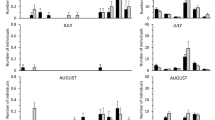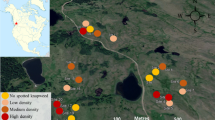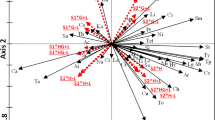Abstract
The seasonal assembly of arthropod communities is shaped by biotic and abiotic aspects of the habitat that limit the appearance or activity phenology of potential community members. In addition, previous interactions within the community, such as herbivore-induced plant defensive responses, aggregation, and predator avoidance likely affect the assembly of arthropod communities on individual plants. We observed the phenology of arthropod communities and defensive plant traits on 100 milkweed (Asclepias eriocarpa) individuals at monthly intervals over a growing season. We experimentally wounded a subset of plants each month (April–August) to observe the effect of simulated added herbivore damage on the seasonal assembly of these arthropod communities. All plant traits and measures of arthropod communities changed over the season. The observed response to experimental leaf damage suggested a trend of induced susceptibility in early months, but not late months. Plants receiving early-season simulated herbivory experienced more subsequent leaf damage than unmanipulated plants. We observed several lagged correlations in our study indicating that blue milkweed beetle (Chrysochus cobaltinus) abundance was lower in months following high natural leaf damage, and that the abundance of a secondary omnivore (Lygaeus kalmii) and total predator abundance tended to follow months with high C. cobaltinus abundance. Ahistorical habitat factors determined much of the observed seasonality of arthropod communities, but induced responses to simulated herbivory also contributed historical effects that influenced arthropod community assembly.





Similar content being viewed by others
References
Agrawal AA (2004) Resistance and susceptibility of milkweed: competition, root herbivory, and plant genetic variation. Ecology 85:2118–2133
Agrawal A (2017) Monarchs and milkweed: a migrating butterfly, a poisonous plant, and their remarkable story of coevolution. Princeton University Press, Princeton
Agrawal AA, Fishbein M, Jetter R et al (2009) Phylogenetic ecology of leaf surface traits in the milkweeds (Asclepias spp.): chemistry, ecophysiology, and insect behavior. New Phytol 183:848–867
Ali JG, Agrawal AA (2014) Asymmetry of plant-mediated interactions between specialist aphids and caterpillars on two milkweeds. Funct Ecol 28:1404–1412
Bates D, Mächler M, Bolker B, Walker S (2015) Fitting linear mixed-effects models using lme4. J Stat Softw 67:1–48. https://doi.org/10.18637/jss.v067.i01
Bazzaz F (1975) Plant species diversity in old-field successional ecosystems in southern Illinois. Ecology 56:485–488
Belyea LR, Lancaster J (1999) Assembly rules within a contingent ecology. Oikos 86:402–416
Benbow M, Lewis A, Tomberlin J, Pechal J (2013) Seasonal necrophagous insect community assembly during vertebrate carrion decomposition. J Med Entomol 50:440–450
Boege K, Marquis RJ (2005) Facing herbivory as you grow up: the ontogeny of resistance in plants. Trends Ecol Evol 20:441–448
Buckley LB, Nufio CR, Kirk EM, Kingsolver JG (2015) Elevational differences in developmental plasticity determine phenological responses of grasshoppers to recent climate warming. Proc R Soc B 282:20150441
Chase JM (2003) Community assembly: when should history matter? Oecologia 136:489–498. https://doi.org/10.1007/s00442-003-1311-7
Diamond J (1975) Assembly of species communities. In: Ecology and Evolution of Communities, pp 342–344
Dunne JA, Harte J, Taylor KJ (2003) Subalpine meadow flowering phenology responses to climate change: integrating experimental and gradient methods. Ecol Monogr 73:69–86
Dussourd DE (1999) Behavioral sabotage of plant defense: do vein cuts and trenches reduce insect exposure to exudate? J Insect Behav 12:501–515
Farrell BD (2001) Evolutionary assembly of the milkweed fauna: Cytochrome oxidase I and the age of Tetraopes beetles. Mol Phylogenet Evol 18:467–478
Feeny P (1970) Seasonal changes in oak leaf tannins and nutrients as a cause of spring feeding by winter moth caterpillars. Ecology 51:565–581
Forkner RE, Marquis RJ, Lill JT (2004) Feeny revisited: condensed tannins as anti-herbivore defences in leaf-chewing herbivore communities of Quercus. Ecol Entomol 29:174–187
Forrest JR, Thomson JD (2011) An examination of synchrony between insect emergence and flowering in Rocky Mountain meadows. Ecol Monogr 81:469–491
Fridley J, Stachowicz J, Naeem S et al (2007) The invasion paradox: reconciling pattern and process in species invasions. Ecology 88:3–17
Halitschke R, Schittko U, Pohnert G et al (2001) Molecular interactions between the specialist herbivore Manduca sexta (Lepidoptera, Sphingidae) and its natural host Nicotiana attenuata. III. Fatty acid-amino acid conjugates in herbivore oral secretions are necessary and sufficient for herbivore-specific plant responses. Plant Physiol 125:711–717
Helmus MR, Dussourd DE (2005) Glues or poisons: which triggers vein cutting by monarch caterpillars? Chemoecology 15:45–49
Hougen-Eitzman D, Karban R (1995) Mechanisms of interspecific competition that result in successful control of Pacific mites following inoculations of Willamette mites on grapevines. Oecologia 103:157–161
Kaplan I, Denno RF (2007) Interspecific interactions in phytophagous insects revisited: a quantitative assessment of competition theory. Ecol Lett 10:977–994
Keddy PA (1992) Assembly and response rules: two goals for predictive community ecology. J Veg Sci 3:157–164
Kraft NJ, Adler PB, Godoy O et al (2015) Community assembly, coexistence and the environmental filtering metaphor. Funct Ecol 29:592–599
Krimmel BA, Pearse IS (2013) Sticky plant traps insects to enhance indirect defence. Ecol Lett 16:219–224. https://doi.org/10.1111/ele.12032
Lawton J, Hassell M (1981) Asymmetrical competition in insects. Nature 289:793–795
Lill JT, Marquis RJ (2003) Ecosystem engineering by caterpillars increases insect herbivore diversity on white oak. Ecology 84:682–690
Maire V, Gross N, Börger L et al (2012) Habitat filtering and niche differentiation jointly explain species relative abundance within grassland communities along fertility and disturbance gradients. New Phytol 196:497–509
Malcolm SB, Zalucki MP (1996) Milkweed latex and cardenolide induction may resolve the lethal plant defence paradox. Entomol Exp Appl 80:193–196
Martel JW, Malcolm SB (2004) Density-dependent reduction and induction of milkweed cardenolides by a sucking insect herbivore. J Chem Ecol 30:545–561
McMunn MS (2017) The timing of leaf damage affects future herbivory in mountain sagebrush (Artemisia tridentata). Ecology 98:1996–2002
Nakagawa S, Schielzeth H (2013) A general and simple method for obtaining R2 from generalized linear mixed-effects models. Methods Ecol Evol 4:133–142
Nufio CR, McGuire CR, Bowers MD, Guralnick RP (2010) Grasshopper community response to climatic change: variation along an elevational gradient. PLoS ONE 5:e12977
Oksanen J, Blanchet FG, Kindt R et al (2010) vegan: Community Ecology Package
Parmesan C, Yohe G (2003) A globally coherent fingerprint of climate change impacts across natural systems. Nature 421:37–42. https://doi.org/10.1038/nature01286
Piovia-Scott J, Yang LH, Wright AN (2017) Trophic cascades in time: the causes and consequences of temporal variation in the strength of top-down effects. Annu Rev Ecol Evol Syst 48
Polgar CA, Primack RB (2011) Leaf-out phenology of temperate woody plants: from trees to ecosystems. New Phytol 191:926–941
Quintero C, Lampert EC, Bowers MD (2014) Time is of the essence: direct and indirect effects of plant ontogenetic trajectories on higher trophic levels. Ecology 95:2589–2602
Rasmann S, Agrawal AA, Cook SC, Erwin AC (2009) Cardenolides, induced responses, and interactions between above- and belowground herbivores of milkweed (Asclepias spp.). Ecology 90:2393–2404
Roitberg BD, Prokopy RJ (1987) Insects that mark host plants. Bioscience 37:400–406
Rudolf VH, Armstrong J (2008) Emergent impacts of cannibalism and size refuges in prey on intraguild predation systems. Oecologia 157:675–686
Shiojiri K, Karban R (2008) Seasonality of herbivory and communication between individuals of sagebrush. Arthropod-Plant Interact 2:87–92. https://doi.org/10.1007/s11829-008-9037-4
Song C, Altermatt F, Pearse IS, Saavedra S (2018) Structural changes within trophic levels are constrained by within-family assembly rules at lower trophic levels. Ecol Lett 21:1221–1228
Strathdee A, Bale J, Block W et al (1993) Effects of temperature elevation on a field population of Acyrthosiphon svalbardicum (Hemiptera: Aphididae) on Spitsbergen. Oecologia 96:457–465
Thibault KM, Brown JH (2008) Impact of an extreme climatic event on community assembly. Proc Natl Acad Sci 105:3410–3415
Van Zandt PA, Agrawal AA (2004) Community-wide impacts of herbivore-induced plant responses in milkweed (Asclepias syriaca). Ecology 85:2616–2629
Wainwright CE, Wolkovich EM, Cleland EE (2012) Seasonal priority effects: implications for invasion and restoration in a semi-arid system. J Appl Ecol 49:234–241
Wetzel WC, Screen RM, Li I et al (2016) Ecosystem engineering by a gall-forming wasp indirectly suppresses diversity and density of herbivores on oak trees. Ecology 97:427–438
Wolkovich EM, Cleland EE (2011) The phenology of plant invasions: a community ecology perspective. Front Ecol Environ 9:287–294
Yang LH (2012) The ecological consequences of insect outbreaks. In: Insect outbreaks revisited. Wiley, Boston, pp 197–218
Zalucki MP, Malcolm SB, Hanlon CC, Paine TD (2012) First-instar monarch larval growth and survival on milkweeds in southern California: effects of latex, leaf hairs and cardenolides. Chemoecology 22:75–88
Acknowledgements
We thank Vince Voegeli and the UC Natural Reserves system for access to Hastings Natural History Reserve. Griffin Hall, Lindsay Brandt, Jill Baty, and Sandra Ferguson helped with arthropod surveys. David Zaya provided useful advice on statistics. Any use of trade, firm, or product names is for descriptive purposes only and does not imply endorsement by the U.S. Government. This project was supported in part by a National Science Foundation (NSF) CAREER Grant (DEB-1253101) awarded to LHY. The data and analyses for the study were archived on USGS ScienceBase https://doi.org/10.5066/P99MQF8J.
Author information
Authors and Affiliations
Corresponding author
Additional information
Handling Editor: Heikki Hokkanen.
Rights and permissions
About this article
Cite this article
Pearse, I.S., McMunn, M. & Yang, L.H. Seasonal assembly of arthropod communities on milkweeds experiencing simulated herbivory. Arthropod-Plant Interactions 13, 99–108 (2019). https://doi.org/10.1007/s11829-018-9660-7
Received:
Accepted:
Published:
Issue Date:
DOI: https://doi.org/10.1007/s11829-018-9660-7




